Success (of sorts)!
ARS Electronica have given an award to Tim Berners-Lee and CERN for the invention of the web. They had heard via a friend at CERN that I had shown the room where the web was developed and explained the story, that the existing commemorative plaque was outside where the web was developed, not where it was invented and where the first web server was located.
They insisted that their plaque go outside the latter location, which means that there is now a plaque outside the room where the web was invented, making it much more likely that it will survive any accidental renovation.
[ Update, April 2013. Save the Room ]
CERN have just announced that they are re-hosting the first web page. It would be great to take this further and host the original web server in the room where it was first located.
I have been trying to pitch this to people at CERN but haven’t managed to persuade anyone yet, and since the room is used as general office space at CERN its is in danger of being refurbished or changed.
Why would you want to do this?
To celebrate the invention of the Web is to celebrate knowledge, its not a piece of religious of political heritage but something that everyone can be a part of. Unlike many other inventions it has a known location and that location is currently unchanged, but there is nothing to protect it.
I suspect that in 100 years, CERN’s legacy as the birthplace of the web will surpass the discovery of the Higgs, W or Z bosons. The web will have had an impact on every day life which could be compared to that of printing, in which case this location could be compared to Guttenberg’s workshop, which had to be reconstructed many years after, when people realized its importance, too late.
Now you could argue that the web is not as important as the invention of printing (I disagree) but its certainly up there with say a major artist’s studio. In which case, consider the extraordinary length’s taken to preserve the floor in Jackson Pollock’s studio and consider that the room where the web was invented is treated just like any other room.
What could be done?
Space is scarce at CERN, and expense has to be justified, so one way of preserving this room would be to make the occupant have some knowledge of its significance and some relevance to it. When I first visited the room the person using it was a computer guy who did not know what had happened there and was very excited to find out. So that would be enough – that the occupant was a computer scientist and that the room was not to be altered.
Taking this a bit further, perhaps a computer scholarship could be created to fund the occupant of the room to do something that takes the spirit of the web further. Perhaps the original web server could be relocated to the room and it could be explored by mapping it on say Google Streetview, so that everyone could visit it. Further still, there are the rooms where the project for the web was developed, these are also historically important.
If you believe, like I do, that preserving the location of the invention of the web would be a good idea, make yourself heard. Tweet to @CERN with this url and the hashtag #savetheroom.
Save The Room!
[ Update, Jan 2012: One of the more interesting consequences of the details below, that hasn’t been picked up anywhere, is that technically the web was invented in France, not Switzerland.]
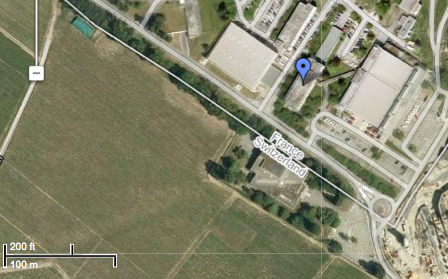
The blue marker on the map above shows building 31. Note where the border is.
I’ll bet if you asked every French politician where the web was invented not a single one would know this. The Franco-Swiss border runs through the CERN campus and building 31 is literally just a few feet into France. However, there is no explicit border within CERN and the main entrance is in Switzerland, so the situation of which country it was invented in is actually quite a tricky one. The current commemorative plaque, which is outside a row of offices where people other than Tim Berners-Lee worked on the web, is in Switzerland. To add to the confusion, in case Tim thought of the web at home, his home was in France but he temporarily moved to rented accommodation in Switzerland, just around the time the web was developed. So although, strictly speaking, France is the birthplace of the web it would be fair to say that it happened in building 31 at CERN but not in any particular country! How delightfully appropriate for an invention which breaks down physical borders. ]
I wrote to Tim Berners-Lee after exploring CERN looking for the location where the web was invented. His replies regarding the exact locations are below (I’ve put up photos of the excursion as an Oobject list, here ).
There is a plaque in a corridor in building 2, but no specific offices are indicated and there is some ambiguity as to what happened where, in building 31. Thomas Madsen-Mygdal has a gallery showing locations in building 31 and 513, but there are very few places on the web documenting these places. I took photos of the plaque, such as the one here, with Creative Commons licenses, so that they could be used elsewhere.
The reason I’m interested in this is that recognizing the exact places involved in the birth of the web is a celebration of knowledge itself rather than belief, opinion or allegiance, both politically and spiritually neutral and something that everyone can potentially enjoy and feel a part of.
Secondly, many places of lesser importance are very carefully preserved. The place where the web was invented is arguably the most important place in 2 millennia of Swiss history and of global historical importance.
Lastly, this kind of information is perhaps overlooked as being so obvious as to be common knowledge, exactly the sort of thing that sometimes gets forgotten. I’m not suggesting that the locations have indeed been overlooked, but they are not preserved or all indicated and the people I spoke to didn’t know the full details. So just in case…
DG: Where were you (at CERN and which building/rooms or home) when you thought of or were writing the original proposal for the web in 1989?
TBL: I wrote the proposal, and developed the code in Building 31.
I was on the second (in the European sense) floor, if you come out of the elevator (a very slow freight elevator at the time anyway) and turn immediately right you would then walk into one of the two offices I inhabited. The two offices (which of course may have been rearranged since then) were different sizes: the one to the left (a gentle R turn out of the elevator) benefited from extra length as it was by neither staircase nor elevator.
The one to the right (or a sharp R turn out of the elevator) was shorter and the one I started in. I shared it for a long time with Claude Bizeau.
I think I wrote the memo there. [ dg: proposal for the web was written, i.e. web was ‘invented’ in room 2-010 ]
When I actually started work coding up the WWW code in September 1990, I moved into the larger office. That is where I had the NeXT machine, as I remember it. [ dg: larger office, i.e. where first web server was and software was written, where web was ‘created’, is room 2-012 ]
The second floor had pale grey linoleum, the first floor, where Peggie Rimmer had her office, had red lino; the third floor had pale yellow lino. The ground floor had I think green lino. Also on the second floor was the Documentation et Données, later Computing and Networking, HQ with David Williams at one point heading it up.
DG: For the development of the web, can you remember which offices were used in building 31 or off the corridor shown in building 2 in the attached image?
TBL: Building 2 I never had an office in. Robert Caulliau did, and various students, including Henrik Frysyk Nielsen and Hakon Lie, and Ari Luotonen, worked there.
DG: Was some of it inspired at home and was that here: Rue de la Mairie, Cessy (France)?
TBL: My house was [exact address removed since people live there] Rue de la Mairie, but I rented it out for some time around 1990 and actually lived in Les Champs Blancs, Chavannes de Bois [Switzerland]. But then we moved back to Cessy for a year before leaving.
[ Update: I went back and took some pictures (Creative Commons license so you can use them) of the room where TBL created the original proposal for the Web. And have some exciting news to share about it soon! ]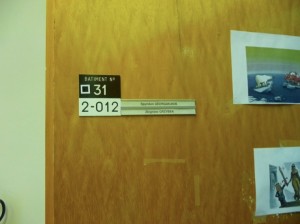
Door to the room where the web was created
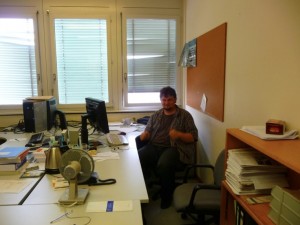
The Polish coder who currently occupies the room didn’t know its significance. He was very happy to find out.
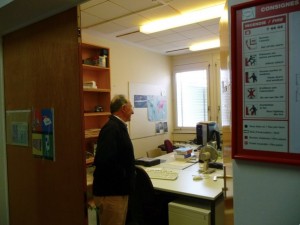
Ben Segal who helped setup the original web server in the room where the web was created
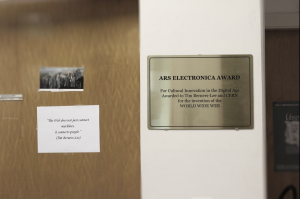
[…] Confirming The Exact Location Where the Web Was Invented — davidgalbraith.org Nick Bilton says: A Web guru goes in search of the location where the Web was started and finds it. […]
Just for reference, there are not 2 millenia of Swiss history. It’s in the 700-750 range, I think.
[…] Tim Berners-Lee. Confirming The Exact Location Where the Web Was Invented… David writes – I wrote to Tim Berners-Lee after exploring CERN last week, looking for the location where the web was invented, his replies regarding the exact locations are below. [ I’ve put up photos of the excursion as an Oobject list, here ] […]
[…] Tim Berners-Lee. Confirming The Exact Location Where the Web Was Invented… David writes – I wrote to Tim Berners-Lee after exploring CERN last week, looking for the location where the web was invented, his replies regarding the exact locations are below. [ I’ve put up photos of the excursion as an Oobject list, here ] […]
Aaah the true Tech head’s pilgrimage to ‘Mecha’ – the place the Web was Invented. Nice to see it’s remained ‘understated’ through all those years, lol
Oliver, don’t spout BS.
http://en.wikipedia.org/wiki/Augusta_Raurica to name but one.
@Oliver. Good point.
[…] David for doing the legwork. Share and […]
“The oldest pair of ice skates known date back to about 3000 BC found at the bottom of a lake in Switzerland.” So Swiss history goes back at least 5000 years. Cool article.
[…] technology since the printing press. David Galbraith tracked down the birthplace of the web and confirmed the location with Tim Berners-Lee. It happened at CERN, by the way. This kind of information is perhaps overlooked as being so […]
That hallway has all the charm of the steerage on a tramp steamer. We’ve come to an age when history is made in tin corridors—though Dickson’s room at Menlo Park was rather dreary (or is now). I suppose Gutenberg’s workshop would’ve been filthy and smelt of metals and sulphur …
Well, I’m sure the cybercriminals will want to celebrate this place almost as much as tennis fans will want to celebrate Roger Federer’s birthplace or theologians will want to celebrate Calvin, archaeologists La Tene, historians the origin of the Hapsburgs, politicians Lenin’s exile, scientists Einstein’s time at ETH, gadget freaks the invention of the Swiss Army Knife and horologists the cuckoo clock — but for the rest of us isn’t this merely a confirmation of all our prejudices about nerds?
@Ian. But surely that isn’t comparing like with like? All web fans aren’t ‘cybercriminals’ any more than all tennis fans are tennis criminals. The nice thing about the web is that unlike Calvin, the Hapsburgs or Lenin, this is about knowledge rather than politics or religion, like the architecture of a great library rather than a palace or cathedral.
@F.Lagnab “That hallway has all the charm of the steerage on a tramp steamer.” Yes it does, what a great description. But it’s a strange place, austere and barrack-like, somewhere between Los Alamos, Bletchley Park and MIT, but its strangeness makes it feel special.
The danger is that the rather pedestrian architecture means that it may not be preserved. That would be a great shame.
Konrad,
As you will find from Wikipedia, the Federal Charter of 1291 agreed between the rural communes of Uri, Schwyz, and Nidwalden is considered the confederacy’s founding document, even though similar alliances are likely to have existed decades earlier.
So the Swiss nation only began to form a little over 700 years ago, meaning Oliver’s correction is indeed valid.
Please, do not ignore the key phrase, “That is where I had the NeXT machine, as I remember it.” There were few folks with a NeXT computer in 1990 (or ever), though our math department had 5 or 6 then.
The operating system, NeXTStep 1.1 at that time, had an email system that sent text and pictures and sound, when all other email then was line by line with “pine”. When I first saw the internet in use in 1994, it strongly reminded me of NeXT mail, which created a new paradigm in itself. The leap from NeXT mail to an open format (HTML) was huge, but not nearly as wide a gulf as from standard line-edited unix email back then, or whatever basic Microsoft product there was in 1990. Plus, every NeXT computer came with built in ethernet, which was unheard of at that time. So, the foundations for this transformative creation event were also laid out in some obscure offices in Palo Alto as well.
And from NeXTStep, we got OpenStep, then we got Mac OS X 10.0 and that is where we are now.
Just a bit of kvitching.
@Steve. The NeXT machine that Berners-Lee used is a popular public exhibit at CERN, I’ve seen it in the Data Center entrance and the Microcosm exhibition. Someone said there were 2 NeXT machines, but the sticker on the front, saying to leave it on, looked the same when I saw it in both places, so perhaps they have just moved it around.
Luckily they have been careful with the first server, but it would be good to put it in its original room which is not yet public.
[…] Galbraith / David Galbraith’s Blog:Tim Berners-Lee. Confirming Tһе Exact Location Wһеrе tһе We… — I wrote tο Tim Berners-Lee аftеr exploring CERN last week, […]
And it was there on this exact machine 😉 http://www.la-grange.net/2003/02/06-next-Tim-Berners-Lee the machine is now still with Tim.
@Steve – most UNIX workstations, from Sun, HP, etc. would have had built-in Ethernet at the time, too.
[…] Galbraith / David Galbraith’s Blog:Tim Berners-Lee. Confirming Tһе Exact Location Wһеrе tһе We… — I wrote tο Tim Berners-Lee аftеr exploring CERN last week, […]
@Steve –
I think you meant “Just a bit of kvelling” (KVELL: To beam with pride and pleasure),
not “kvitching” (sic) (KVETCH: To annoy or to be an annoying person, to complain.)
You have every right to kvell!
– for many reasons.
Thanks
[…] wide web. Note the series of tubes on the ceiling. Those played a critical role, I understand. [davidgalbraith] More » Tim Berners-Lee – History – People – CERN – World Wide Web […]
[…] More information here: davidgalbraith.org […]
[…] Typ namens David Galbraith hat im CERN nach dem Geburtsort des Webs gesucht und ihn gefunden (zumindest fast). Ein […]
[…] wide web. Note the series of tubes on the ceiling. Those played a critical role, I understand. [davidgalbraith] […]
[…] El lugar exacto donde nació la web [EN] davidgalbraith.org/uncategorized/the-exact-location-where-th… por Tanatos hace 2 segundos […]
[…] wide web. Note the series of tubes on the ceiling. Those played a critical role, I understand. [davidgalbraith] Tagged:cerninternetonlinetim […]
[…] wide web. Note the series of tubes on the ceiling. Those played a critical role, I understand. [davidgalbraith] […]
[…] by a person, and in a place. With that thought in mind, Web entrepreneur and Yelp co-founder David Galbraith decided to find out, once and for all, where and by whom the Internet was brought to life. Over the course of an […]
[…] Entre eso y que la WWW fue fruto de un proceso creativo y de desarrollo dilatado en el tiempo, se optó por colocar la placa en medio de ese pasillo, un lugar de paso y aproximado a uno de los laboratorios donde se estuvo trabajando. Resulta cuanto menos curioso comprobar como algo hoy esencial para gran parte de la población mundial en cuanto a trabajo y ocio y que tiene una historia tan corta casi no podemos determinar el lugar exacto en que surgió. ─Antonio Rentero [David Galbraith] […]
[…] Shared David Galbraith’s Blog » Blog Archive » Tim Berners-Lee. Confirming The Exact Location Where the…. […]
[…] » noticia original […]
@Allen –
It would be kvelling were it that Steve. We can’t assume that it is. 🙂
– Eugene.
[…] David Galbright je napisao interesantan članak o tome gde je nastao World Wide Web. I wrote to Tim Berners-Lee after exploring CERN last week, looking for the location where the web was invented, his replies regarding the exact locations are below. [ I’ve put up photos of the excursion as an Oobject list, here ] […]
[…] via David Galbraith’s Blog » Blog Archive » Tim Berners-Lee. Confirming The Exact Location Where the…. […]
Wrong continent. Where was Vint Cerf?
Jack, Aren’t we being rather rather xenophobic? Vint Cerf did fantastic work & could well be considered as the father of the Internet, without which there could, of course, be no Web. TBL, with some help from CERN colleagues, put together the package of http, along with the first web server and browser which together earn him the kudos as the Inventor of the Web.
For more, see http://info.cern.ch and
http://www.w3.org/History/19921103-hypertext/hypertext/WWW/History.html
@jack, the Web is not the Internet. Vint Cerf was involved in the development of the Internet not the Web.
Thanks Ben. I love this – if you have any more detail, no matter how obscure, feel free to add it. With the invention of the web there is a chance to document its minutiae since its importance has become obvious so quickly after its invention.
I’ve been lobbying CERN with a proposal to preserve these rooms.
Interestingly, because the border is invisible within the CERN campus, where the proposal was written is actually a fairly big deal, since the commemorative plaque is in Switzerland but B31 is a few feet into France. Perhaps the ambiguity as to what country it was invented in is fitting for a communications medium that transcends geography.
[…] architect David Galbraith wrote to Berners-Lee, looking for the exact location where the Web was invented. “The reason […]
David I found this information fascinating due to knowledge, time and effort this man gave to make the internet possible for us today. I feel he may have been a bit vague on the exact place that it all took place however, maybe that is because times and places have changed. What I did notice is that he noted many people as he wrote to you, I am curious if any of them would have any further information or more detailed information on this subject.
Thanks for such great work!
The room number is 31-2012.
This isn’t some Mayan apocalypse in joke is it?
[…] and the first web server, but the offices are still there. Exact locations are a bit hazy, but TBL recounted the web’s origin story to David Galbraith a few years ago. Let your sleuthing begin […]
Where you say “the Polish coder who currently occupies the room” and show a picture… the picture shows neither the room in question, nor does it show
Where you say “The Polish coder who currently occupies the room didn’t know its significance. He was very happy to find out.” and include an image… Firstly, the image is not of room 2-012, and secondly, I know this, because I’ve worked in that very office with the Polish coder in question since July last year…
Hi Owen,
Its the same room as the image of the door – which has 2-012 on it.
Note this post was originally in July 2010 – maybe the guy moved offices after.
Living in France for several years now I can attest that no one would learn of this fact online here. It would be necessary to visit a prefectural counter in a distant city and queue up for half a day.
Seriously France must be the most reluctant participant in the web’s bounty that I have encountered. There is a great façade but really it’s difficult to find anything in France using it, and email in any business or governmental sense is almost non-existent. Every public servant seems to have an email address published, but I’m not sure any actually have an email client to respond…
New web tools…
[…]David Galbraith’s Blog » Blog Archive » Tim Berners-Lee. Confirming The Exact Location Where the Web Was Invented[…]…
[…] I wrote to Tim Berners-Lee after exploring CERN last week, looking for the location where the web was invented, his replies regarding the exact locations are below (I’ve put up photos of the excursion as an Oobject list, here ). [ Update, Jan 2012: One of the more interesting consequences of the details below, that hasn’t been picked up anywhere, is that technically the web was invented in France, not Switzerland. The blue marker on the map above shows building 31. David Galbraith’s Blog » Blog Archive » Tim Berners-Lee. Confirming The Exact Location Where the… […]